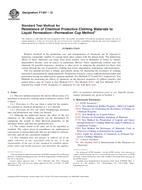We need your consent to use the individual data so that you can see information about your interests, among other things. Click "OK" to give your consent.
ASTM F1407-12
Standard Test Method for Resistance of Chemical Protective Clothing Materials to Liquid Permeation—Permeation Cup Method
STANDARD published on 1.6.2012
The information about the standard:
Designation standards: ASTM F1407-12
Note: WITHDRAWN
Publication date standards: 1.6.2012
SKU: NS-50170
The number of pages: 6
Approximate weight : 18 g (0.04 lbs)
Country: American technical standard
Category: Technical standards ASTM
The category - similar standards:
Annotation of standard text ASTM F1407-12 :
Keywords:
chemical protective clothing, liquid permeation, permeation, permeation cup method, ICS Number Code 13.340.10 (Protective clothing)
Additional information
| Significance and Use | ||||||||||||||||
|
This test method establishes a standard procedure for rapidly (in 1 h or less) determining the chemical resistance of specimens of protective clothing materials. This test method can be used to rank materials as to their suitability for use with liquids of known or unknown composition. The breakthrough detection time, permeation rate, or cumulative permeation can be used to identify protective clothing materials that are more likely to limit potential exposures to chemicals. Longer breakthrough detection times and lower cumulative amounts permeated and permeation rates are characteristics of materials that are better barriers to the test chemical. In general this test method is less sensitive than Test Method F739 coupled with sensitive analytical procedures. In cases where the chemical of concern is highly toxic and contact of even a very small amount with the skin may be detrimental to health, the permeation cup method is not recommended. Use Test Method F739. Upon permeating the clothing material, the chemical must evaporate in order for a weight loss to occur and permeation to be detected. Consequently, the test method may not be applicable for chemicals having low volatility (that is, vapor pressure). The vapor pressure below which this test method is not applicable has not been determined. A procedure for assessing volatility is described in Section 10. The results of this test method are highly dependent on the test temperature. If the objective is to compare different clothing materials, all tests shall be conducted at the same temperature (±3°C). |
||||||||||||||||
| 1. Scope | ||||||||||||||||
|
1.1 This test method measures the barrier effectiveness of a specimen of protective clothing upon continuous contact with a liquid. 1.1.1 Procedure A—For use when a value for the cumulative amount of chemical permeated in 1 h is desired. 1.1.2 Procedure B—For use when breakthrough detection time and permeation rate values are desired. 1.2 Although not addressed herein, the effect of the test chemical on the clothing material can be determined by comparing the weight or other physical properties of the specimen before and after the permeation test. 1.3 The values stated in SI units are to be regarded as standard. The values given in parentheses are mathematical conversions to inch-pound units that are provided for information only and are not considered standard. 1.4 This standard does not purport to address all of the safety concerns, if any, associated with its use. It is the responsibility of the user of this standard to establish appropriate safety and health practices and determine the applicability of regulatory limitations prior to use. Specific precautionary statements are given in Section 2. |
||||||||||||||||
| 2. Referenced Documents | ||||||||||||||||
|
Similar standards:
Historical
1.7.2013
Historical
1.1.2014
Historical
1.1.2013
Historical
1.7.2012
Historical
1.2.2014
Historical
1.5.2012
We recommend:
Technical standards updating
Do you want to make sure you use only the valid technical standards?
We can offer you a solution which will provide you a monthly overview concerning the updating of standards which you use.
Would you like to know more? Look at this page.



 ASTM F1731-96(2013)..
ASTM F1731-96(2013).. ASTM F1790/F1790M-14..
ASTM F1790/F1790M-14.. ASTM F1819-07(2013)..
ASTM F1819-07(2013).. ASTM F1823-97(2012)..
ASTM F1823-97(2012).. ASTM F1868-14
ASTM F1868-14 ASTM F1891-12
ASTM F1891-12
 Cookies
Cookies
